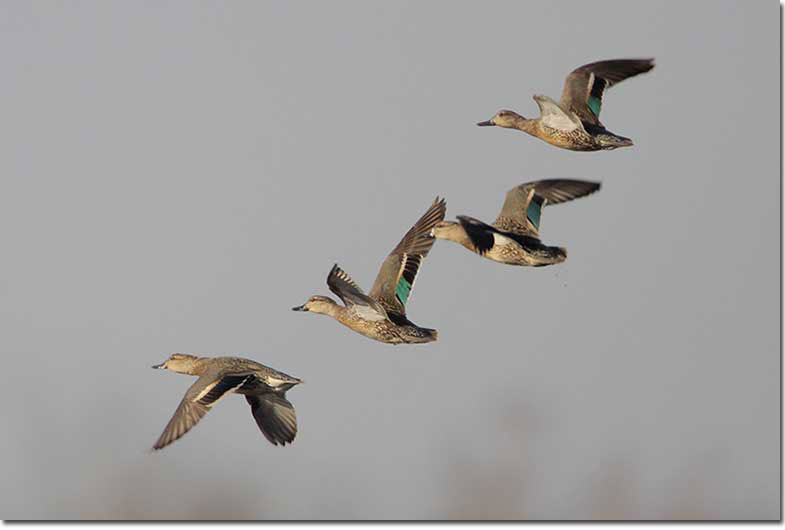
Ducks are beautiful birds! We see these familiar birds on lakes, ponds, feed them, and some of us even have pet ducks.
Most of the ducks we know are Mallards but there are lots of other species! Florida in particular is a great place to see ducks. These aquatic birds are common in the Sunshine State’s marshes, lakes, and other wetland habitats.
In Florida, which ducks have you seen? We bet you’ve seen a lot but which ones could you identify?
This list of the most common ducks in Florida will help!
Most Common Ducks in Florida
According to recent eBird data, our list shows the most common ducks in Florida.
We arranged them from most common to least common and have included information about their behavior. We also mention key field marks to help identify these beautiful birds!
Black-bellied Whistling-Duck
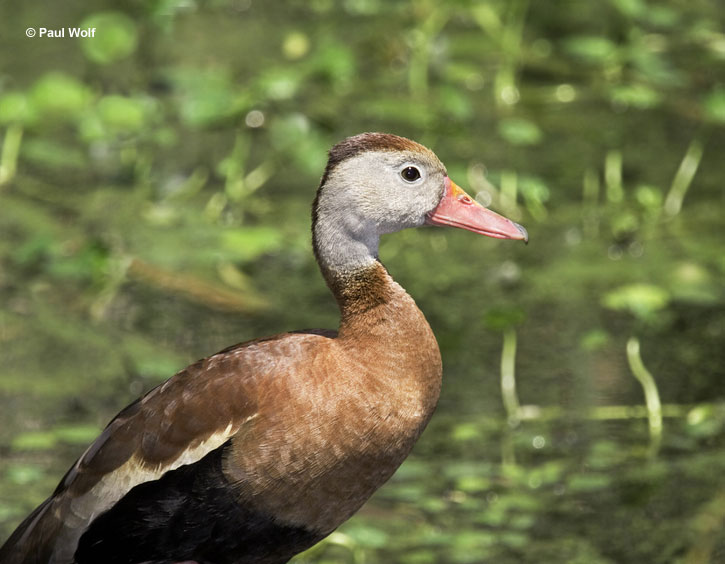
Scientific name: Dendrocygna autumnalis
Length: 21 inches
Wingspan: 30 inches
Black-bellied Whistling-Ducks are big waterfowl with long pink legs and a dark pink beak. If that sounds fancy, it’s true, they are bold and eye-catching birds!
Adults look similar and are chestnut-brown with a black belly and undertail, gray head, and bold white wing stripes. Juveniles have gray beaks and legs.
These ducks are very social birds that flock together in shallow wetlands and rice fields. On account of their tendency to perch in trees, this species and other whistling-ducks used to be known as “tree-ducks”.
However, since they are also very vocal and often make sharp, whistle-like calls, they are known as “whistling ducks”.
This species likes to eat grains and other plant matter, and sometimes occurs in big groups. They are also active at night and nest in tree cavities as well as on the ground. These Florida ducks can be spotted near marshes.
Key identifications:
- Big, goose-like duck with a big pink beak.
- Gray-brown bird with a black belly.
- Long legs, and dark wings with a bold white wing stripe.
Mottled Duck
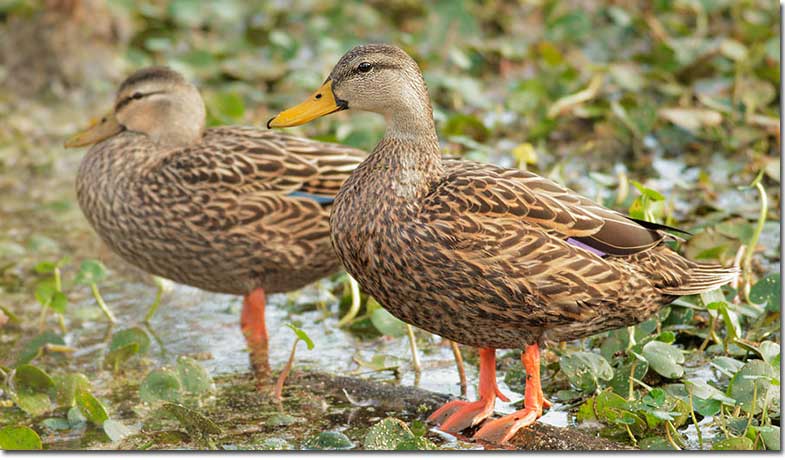
Scientific name: Anas fluvigula
Length: 22 inches
Wingspan: 30 inches
Mottled Ducks are hefty, dark brown ducks with a much paler, buff neck and head. They also have a dark line through each of their dark eyes, buff and dark brown markings on their body, and orange legs. Both sexes look pretty similar except that males have a brighter yellow beak, and females are sometimes paler.
In brief, they are one of the plainer looking duck species in North America. However, although they might not look as pretty as some other birds, the Mottled Duck is pretty special! This waterfowl species has a very small range and only occurs in Florida, on parts of the Gulf of Mexico, and in a few other areas of the southeastern USA.
Read more: What do ducks eat?
These cool birds dabble for plants and small creatures in coastal marshes and other shallow wetlands. We usually see them in pairs but, after breeding, they can flock together and feed in farm fields.
Key identifications:
- Hefty brown duck with a plan buff throat.
- Plain olive or orange-yellow beak.
- Orange legs and wings that are mostly dark above, mostly white below.
Muscovy Duck
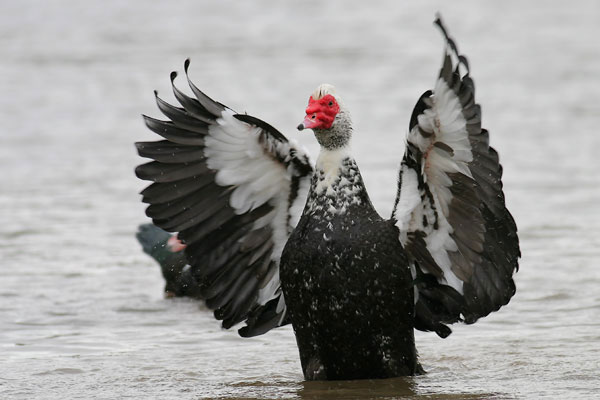
Scientific name: Cairina moschata
Length: 25 inches
Wingspan: 48 inches
Muscovy Ducks are heavy and hefty, goose-like ducks with dark plumage. They have a little bit of a crest, a longish, broad tail, and big, broad wings. When we see this big birds in flight, their wings show prominent, bold white patches.
Muscovy Ducks also have a bicolored beak, and often have some red, warty growths on their face! With a closer look, we can see that the black plumage of this duck species actually has dark green highlights.
The Muscovy Duck likes to perch in trees and float around ponds and other shallow wetlands, especially in wooded areas. They forage for plants and other small animals and are a common farm bird.
Indeed, most of the tame Muscovy Ducks we see in Florida and other places are basically domesticated Muscovy Ducks. The wild ones don’t have any white patches in their plumage except for on their wings, are shyer, and occur in southern Texas.
Key identifications:
- Big, dark, goose-like duck.
- Mostly black with dark green highlights.
- Broad dark wings with white markings.
Blue-winged Teal
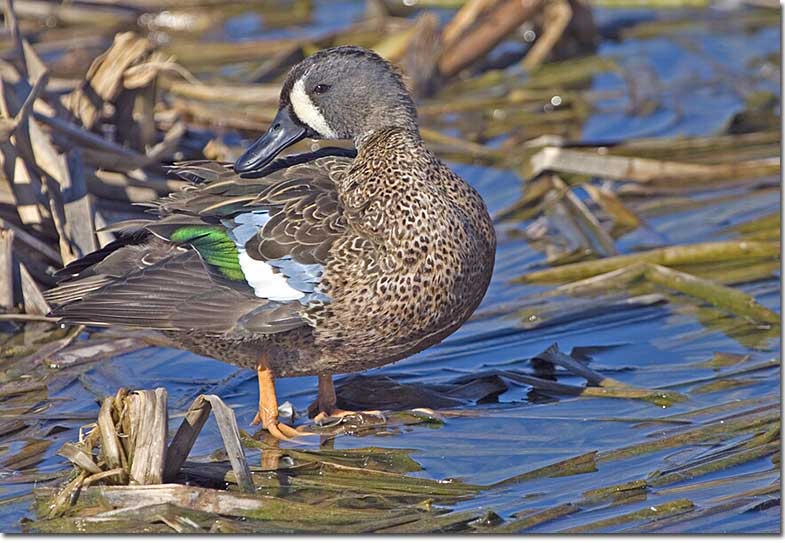
Scientific name: Spatula discors
Length: 15.5 inches
Wingspan: 23 inches
Blue-winged Teals are small ducks with brownish plumage and fairly big, dark beaks. In a lot of places, these little ducks are the commonest waterfowl species. They are also highly migratory and thousands can spend the winter as far south as Panama and northern Colombia!
Male Blue-winged Teals have dark gray heads and a bold white, crescent-shaped patch on their face. They also have a small white patch near their dark tail and a black undertail. Females are duller brown with buff and dark mottling to help hide them during the nesting season.
In flight, just like their name says, both sexes reveal big blue patches on their wings. Blue-winged Teals usually occur in flocks, and in some places, they can number in the thousands!
They like to dabble for plants and small creatures in rice fields, marshes, and other shallow water wetlands. They are fairly common in Florida.
Key identifications:
- Small duck with a dark beak and white crescent mark on its face.
- Female has a dark line through her dark eyes.
- Blue or blue-gray shoulders on its wings.
Wood Duck
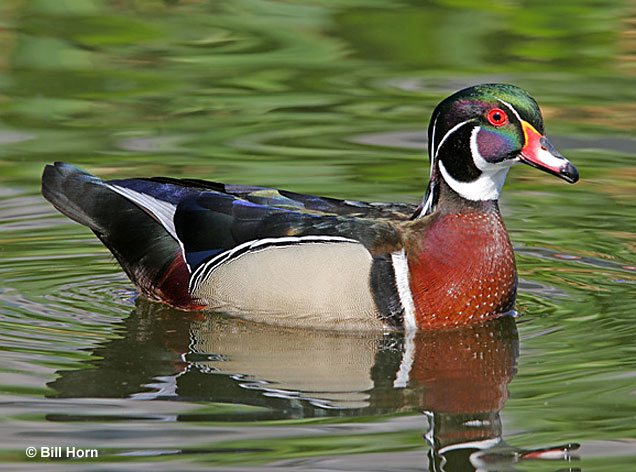
Scientific name: Aix sponsa
Length: 18.5 inches
Wingspan: 30 inches
Wood Ducks are seriously ornamental birds. The males can seem so exotic that it might be hard to believe they are a wild, native species! However, Wood Ducks are indeed native and fairly common in many parts of southern Canada and the USA.
These cute, slender, long-tailed ducks prefer wooded swamps and other wetlands in forested habitats. The males have rounded heads with a dark green crest, black and white faces, short red beaks, and jade green backs. They also have bright buff flanks and a chestnut chest and undertail.
Female Wood Ducks grayish-brown birds that aren’t nearly as fancy but can still be recognized by their blocky head, white spectacles, slender shape, and mostly dark wings.
Wood Ducks usually occur in pairs but can also form small flocks that forage for acorns, plant matter, and small creatures in and near water. It’s possible to hear their odd, squealing whistle vocalization before seeing them.
Key identifications:
- Slender duck with a longish tail and a blocky head.
- Ornate plumage a short, reddish beak.
- Dark wings with a narrow white line on the base of the trailing edge.
Mallard
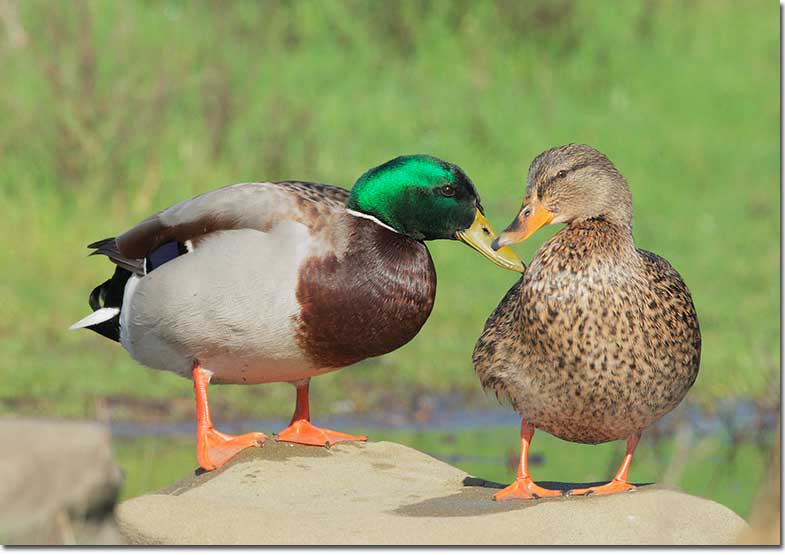
Scientific name: Anas platyrhynchos
Length: 23 inches
Wingspan: 35 inches
Mallards are the most familiar duck species. For lots of folks, this is “the duck”. They have been domesticated for centuries and lots of them are fed at urban ponds and lakes.
However, make no doubt about it, Mallards are wild birds that also live in lots of wild and remote areas in most of North America. The males have a dark green head, narrow white collar, yellowish beak, and dark brown chest.
Female Mallards, though, can be trickier to identify. They are brown with some paler brown and dark markings, and have a gray-brown neck and head with a dark cap, and a dark line through their eyes.
In flight, we can also recognize female Mallards by their pale tail, and two white wing bards bordering a green-blue wing patch.
In addition to eating bird food and vegetables, Mallards dabble in shallow water for plant matter and small creatures.
Key identifications:
- Big duck with a glossy green head and yellowish beak.
- Female has a dark center mark on her orange beak.
- Short, pale or white tail.
Ring-necked Duck
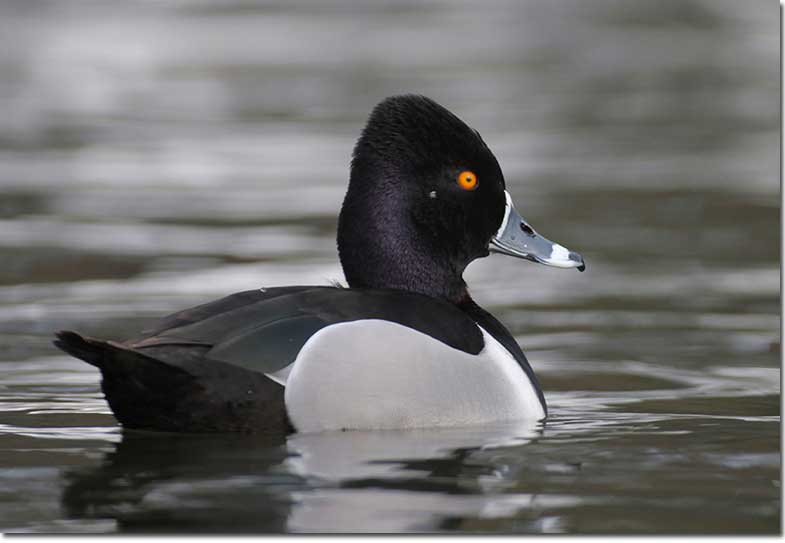
Scientific name: Aythya collaris
Length: 17 inches
Wingspan: 25 inches
Ring-necked Ducks are one of those birds that don’t have the best of names. While males do have a brown ring on their necks, it blends in with their black neck and can be really hard to see.
Ring-necked Ducks should really be called, “Ring-billed Ducks”! The males are best recognized by the white ring near the black tip of their dark gray beak, and their combination of a black back, head, neck, and chest. They also have gray sides and a white mark near their black chest.
Female Ring-necked Ducks are plain, brownish birds with pale bellies and narrow white spectacles on a grayish face. They also show a bit of white on their face, near the base of their bill.
Ring-necked Ducks dabble and make shallow dives for a variety of food items. They like to eat plant matter, insects, and other small aquatic creatures. We find them in a variety of shallow wetlands in much of North America.
Key identifications:
- Male has black back, head, and chest.
- Gray sides with white near the black chest.
- Female has narrow white spectacles on gray face.
Lesser Scaup
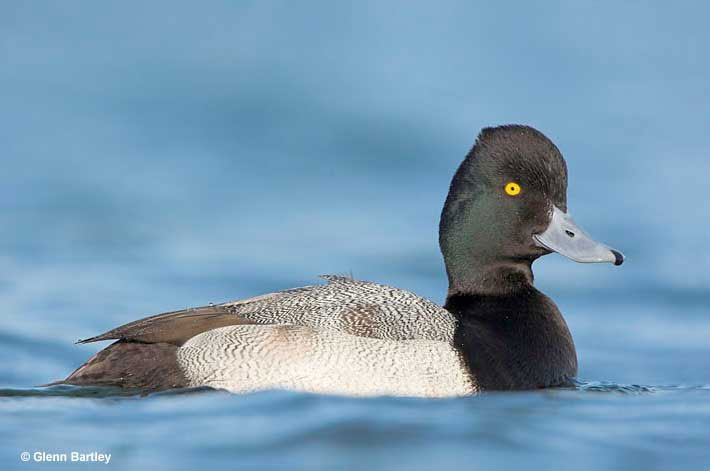
Scientific name: Aythya affinis
Length: 16.5 inches
Wingspan: 25 inches
Lesser Scaups are smallish or medium-sized diving ducks with a blue-gray beak. Males have a black head with dark green highlights, black chest, and black rear end, pale gray back, and white sides and belly.
Female Lesser Scaups are dark brown with a pale belly, and a white mark on their face. Both sexes have the back part of the head more pointed than the front part. That field mark might not sound like much but it’s one of the best ways to tell them from the extremely similar Greater Scaup!
Lesser Scaups dive to forage in lakes, reservoirs, and coastal bays for mollusks, crustaceans, and other aquatic creatures. In migration and winter, they often occur in flocks that can number in the hundreds!
These smart-looking ducks breed on remote lakes and marshes in Alaska, Canada, and in the mountains of the western USA, but winter in Florida.
Key identifications:
- Bluish beak.
- Slightly peaked on the back part of its head.
- Male has black chest, gray body, and dark head, female has a white mark on the front of her face.
Northern Shoveler
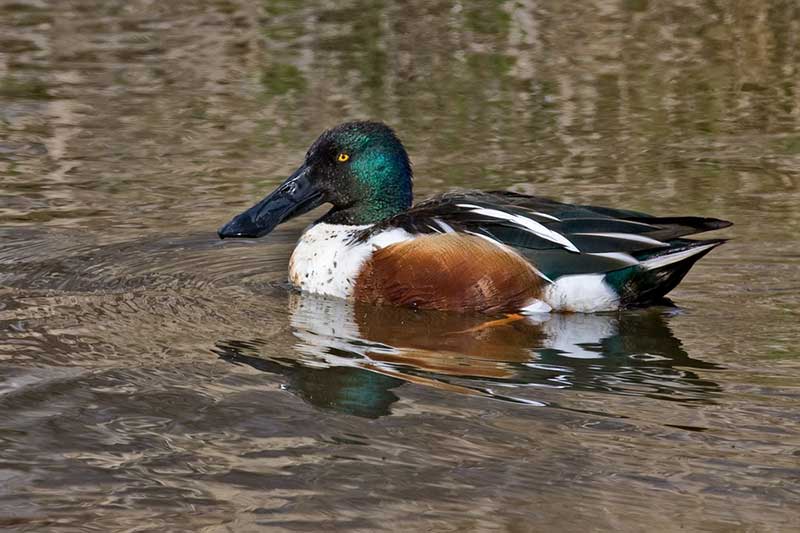
Scientific name: Spatula clypeata
Length: 19 inches
Wingspan: 30 inches
Northern Shovelers are a distinctive duck species with a big, prominent beak. Males have striking plumage with a dark green head, and white and chestnut underparts. They are also white and gray on their back, have orange legs, and show blue shoulders in flight.
Female Northern Shovelers are tawny-brown ducks with lots of buff markings, and an orange and gray beak. Both sexes also have a pale tail.
These pretty ducks like to float in marshes and other shallow wetland habitats. They often form flocks and we can see them foraging with Blue-winged Teals and other dabbling ducks. Like many other duck species, Northern Shovelers feed on a combination of plant matter and small aquatic creatures.
This species breeds in shallow wetlands in Alaska, western and central Canada, and in parts of the northern and western USA, but spend their winters in Florida.
Key identifications:
- Over-sized, flat beak.
- Male has a white breast, red-brown sides and belly, and dark green head.
- Female has a pale tail and orange and gray beak.
Hooded Merganser
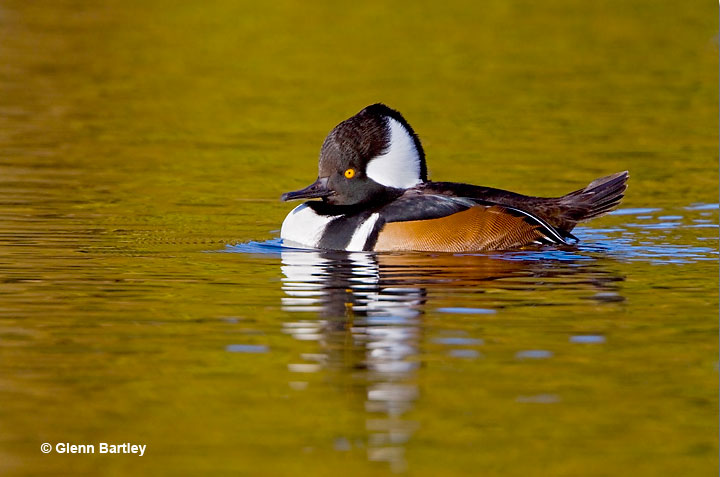
Scientific name: Lophodytes cucullatus
Length: 18 inches
Wingspan: 24 inches
The Hooded Merganser is one of the prettiest little ducks in North America. Breeding males are handsome ducks with a rounded black and white head, and black neck and back. Their jet black upperparts combine nicely with two black marks on a white chest, and rich, pumpkin-colored flanks.
Females aren’t as colorful but are still pretty in their own way. These brown-gray birds have a slender, yellowish beak, and a deep, caramel-colored, rounded crest.
Both sexes also have a longish, somewhat pointed tail, and small white markings on the base of their slender dark wings.
Hooded Mergansers dive for crayfish, small fish, and other small creatures in wooded swamps and marshes. We don’t see them flock together as much as other ducks do, and they usually occur as pairs.
They mostly breed in forests of southern and western Canada, and the northeastern USA, and winter in wooded wetlands in Florida.
Key identifications:
- Small duck with a small, slender beak.
- Blocky or rounded head.
- White belly and a bit of white on the base of narrow wings.
Red-breasted Merganser
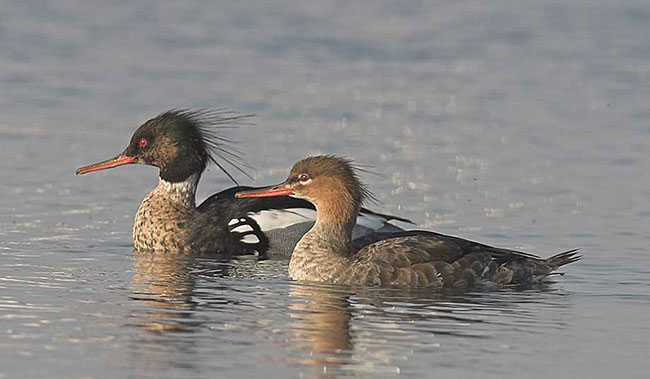
Scientific name: Mergus serrator
Length: 23 inches
Wingspan: 30 inches
Red-breasted Mergansers are big, slender ducks with long, thin beaks. Unlike some ducks we know, you won’t find them paddling around ponds and looking for handouts.
This duck is built for speed! Red-breasted Mergansers can fly at 80 miles per hour! They aren’t that fast when swimming underwater but are still quick enough to catch young trout and other fish.
Male Red-breasted Mergansers have a dark green head, broad white collar, and a dark brown chest border with black and white markings. They also have a black and white back, gray sides, and a white belly.
Females are mostly gray with a tawny head and a white belly. Both sexes have reddish beaks, a double crest, and white on the base of their pointed wings.
This duck species breeds on forested lakes and rivers in Alaska, Canada, and parts of the northern USA. In winter, big flocks dive for fish on The Great Lakes, and in coastal waters.
Key identifications:
- Big, slender duck with a narrow reddish beak.
- Tawny or dark green head with a double crest.
- Much white on the base of long wings.
Northern Pintail
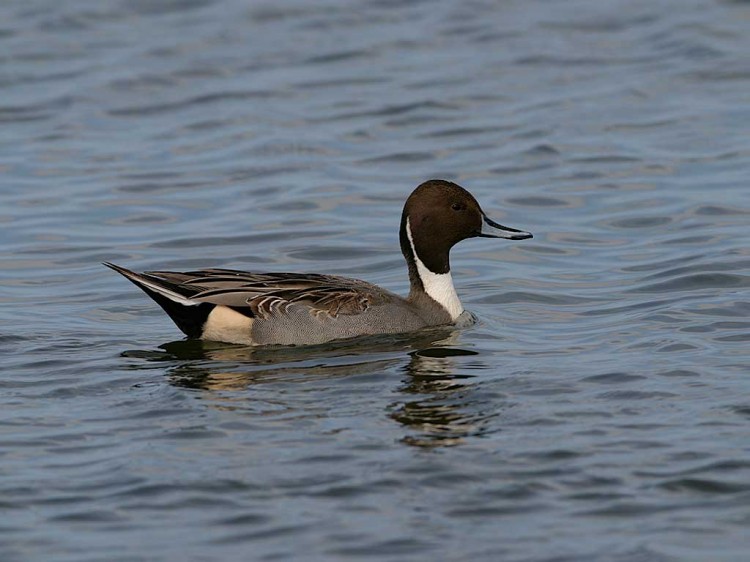
Photograph © Sam Crowe.
Scientific name: Anas acuta
Length: 21 inches
Wingspan: 34 inches
Northern Pintails are fairly large and slender, gray and creamy white ducks with long necks, and long tails. Breeding males are handsome birds with dark, chocolate-brown on their head and neck, a black undertail, and a long pointed tail feather.
Females and nonbreeding males are gray and tawny birds with a plain, pale tawny head and neck, and a gray beak. In flight, Northern Pintails also show long, pale gray wings, and the males have a dark green patch on the base of each wing.
We see these neat ducks in shallow marshes, and on lakes and other wetlands. They often form small groups that can flock with other waterfowl species.
They forage for grains and small aquatic creatures by dabbling in very shallow water and picking food from the wet ground while walking at the edge of the water, and in wet fields.
We see these pretty ducks in shallow wetland habitats in most of North America.
Key identifications:
- Fairly large duck with a long, slender neck.
- Pointed tail.
- Dark brown or tawny head and a gray beak.
Green-winged Teal
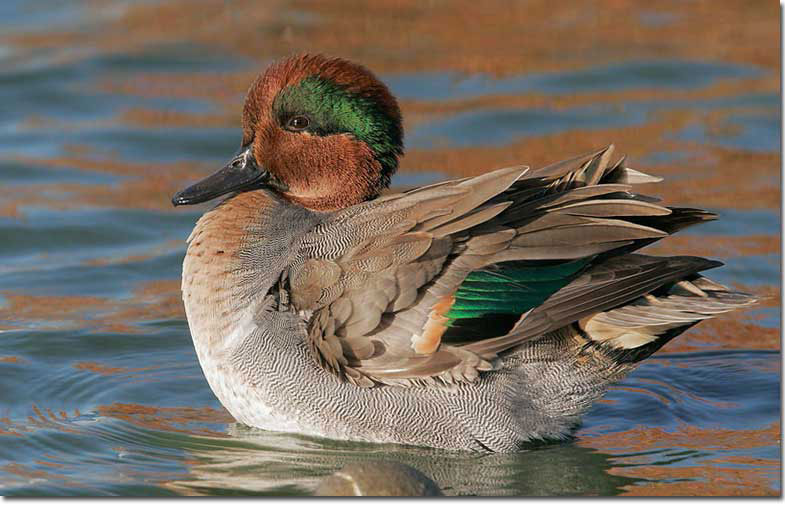
Scientific name: Anas crecca
Length: 14 inches
Wingspan: 23 inches
Green-winged Teals are small waterfowl with a smallish, dark beak, and a dark green patch at the base of each wing. Males of these cute little ducks are mostly gray and have a chestnut head with a dark green patch, speckled, buff chest, and narrow white bar near their chest.
Females are mostly mottled brown with a dark line through each eye. Both sexes have a buff mark on the edge of their tail, and show a white belly in flight.
Green-winged Teal like to forage for plants and small creatures in the shallow water of marshes and other wetland habitats.
They breed in Alaska, Canada, and the northern USA, and winter in a variety of wetland habitats in some parts of southern Canada, and most of the USA.
Although this small duck species can form flocks, we often see them in pairs or only in small groups. They also migrate north later than other duck species.
Key identifications:
- Very small duck.
- Buffy mark along the edge of each side of its tail.
- Small dark beak and dark green patch edged with buff on its wings.
Bufflehead
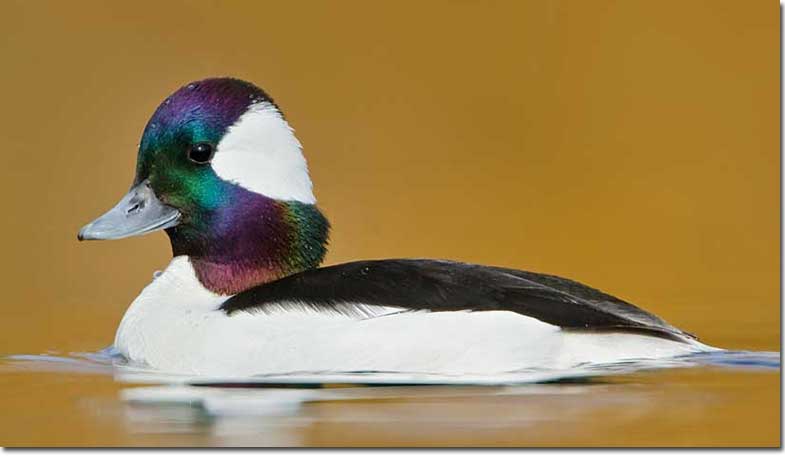
Scientific name: Bucephala albeola
Length: 13.5 inches
Wingspan: 21 inches
Buffleheads are small, cute ducks with rounded heads and stout little beaks. Males are bold, black and white birds with a big white patch on their head. In good light, their head also has green and purple iridescence.
Female Buffleheads are more gray-brown with a white belly, and have a smaller white head patch.
During their fast flight, Buffleheads show a white patch in their wings although the female’s white patch is smaller. These ducks breed on northern, forested lakes in Alaska, Canada, and parts of the northwestern USA.
Like some other small ducks, they need tree cavities for nesting and often use holes made by Northern Flickers.
For the winter, they migrate to coastal waters and lakes, big rivers, and reservoirs in parts of southern Canada and most of the USA.
Buffleheads dive to forage for mollusks and other small creatures. They also occur in flocks, sometimes with goldeneyes and other diving birds, especially in winter.
Key identifications:
- Small chunky duck with stout gray beak.
- Rounded head with a bold white patch.
- Mostly black and white or grayish with a white belly and small white wing patch.
American Wigeon
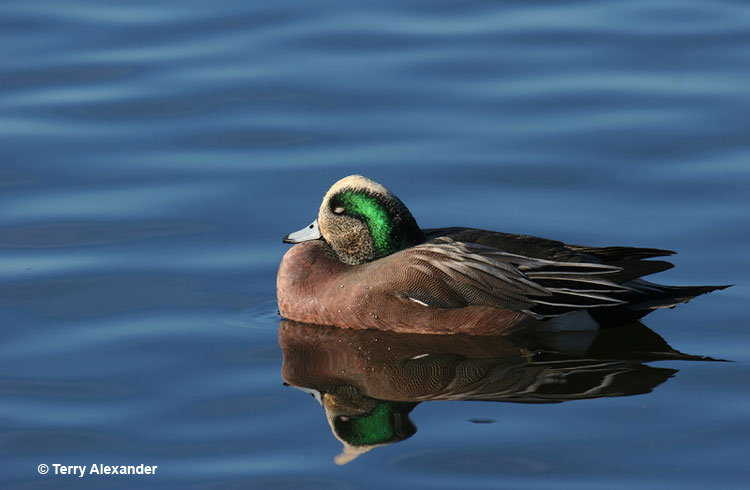
Scientific name: Mareca americana
Length: 20 inches
Wingspan: 32 inches
American Wigeons are medium-sized ducks with a smallish gray beak. Males are gray with a white crown, some dark green near their eyes, and peach-brown colors on their chest and sides.
They also have a black undertail and show white shoulders in flights. Females look like males but lack white and green on their heads and are a bit duller in general. Both sexes have pointed tails and a white belly especially visible in flight.
American Wigeons like to graze grass and eat grain while walking at the edge of wetlands and in wet fields. They can also pick plant matter and small creatures from the surface of the water and even steal food from other ducks!
This waterfowl species breeds in cold, shallow marshes in Alaska, Canada, and parts of the northern USA. They migrate through much of the USA and winter in coastal waters, and on lakes and other wetlands in southern states.
Key identifications:
- Rather small pale gray beak.
- Peach or gray-orange chest and flanks.
- Male has a white crown and white shoulders, female has grayish head with a dark area around her eyes.
Redhead
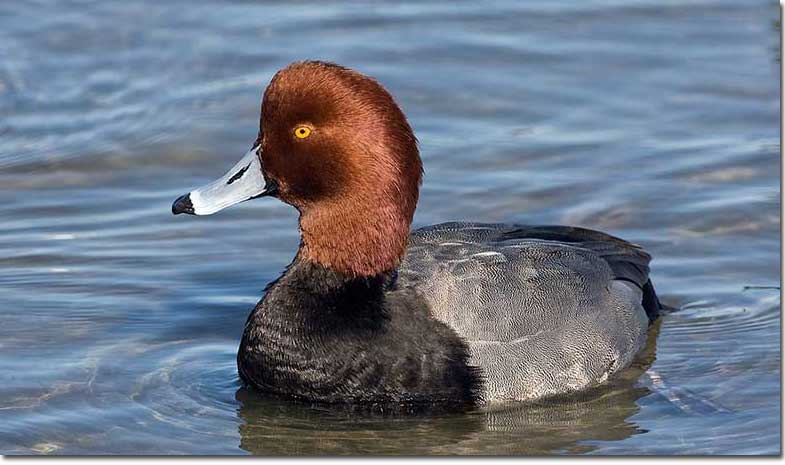
Scientific name: Aythya americana
Length: 19 inches
Wingspan: 29 inches
Redheads are medium-sized ducks that dive in lakes, reservoirs, and bays to catch mollusks and other aquatic animals. Males are eye-catching birds with a bright chestnut head, yellow eyes, pale blue-gray beak with a black tip, black chest and undertail, and gray body.
Females are gray-brown birds that look very different from their male counterparts. Hen Redheads are gray-brown with a paler belly, dark gray beak with a black tip, and plain buffy face.
In flight, both sexes show gray upperwings and much white on their underwings.
Redheads breed in shallow marshes and lakes in Alaska, and central and western North America. In winter, we see these handsome birds on bigger bodies of water in much of the southern USA as well as many coastal waters and parts of the Great Lakes.
After breeding, they can occur in large flocks, especially in the coastal lagoons of South Texas. In that area, wintering Redheads can number in the thousands!
Key identifications:
- Blue-gray beak with a black tip.
- Male has dark gray body, black chest, and bright red-brown head.
- Female mostly tawny-brown with a buff throat.
Ruddy Duck
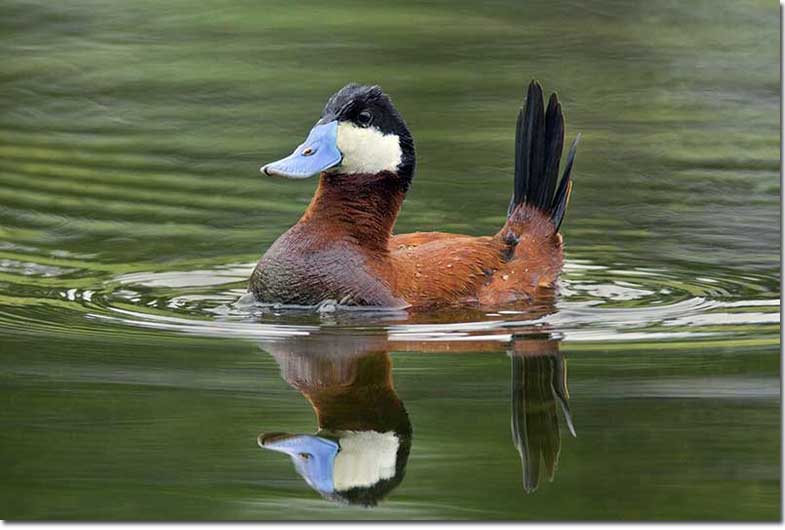
Scientific name: Oxyura jamaicensis
Length: 15 inches
Wingspan: 18.5 inches
Ruddy Ducks are small diving ducks with a unique, big-headed look, and a stiff tail that they often hold upright. Breeding males are a beautiful chestnut bird with a black cap, and a white throat and cheeks. They also have a big and pretty, blue beak that contrasts with the other colors on their head.
Female Ruddy Ducks are grayish birds with darker, more uniform upperparts, and a thick black line on their pale face. They have a duller, darker, more grayish beak than the male. In flight, Ruddy Ducks have mostly dark, rather short and narrow wings.
Ruddy Ducks dive underwater to forage for small aquatic creatures.
This small duck species breeds in shallow marshes and lakes in many parts of central and western North America. They migrate to eastern Canada and the USA and winter on lakes, in coastal waters, and other wetlands in the western and southern USA.
Key identifications:
- Small duck with big bluish beak and a dark cap.
- White cheeks or a dark line on pale cheeks.
- Longish, stiff tail often held upright.
Fulvous Whistling-Duck
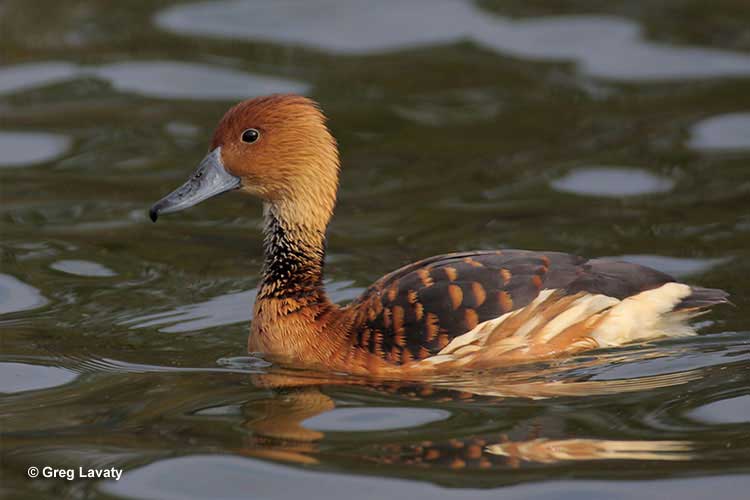
Scientific name: Dendrocygna bicolor
Length: 19 inches
Wingspan: 26 inches
Fulvous Whistling-Ducks are big, goose-like ducks with distinctive, tawny plumage. They have a fair-sized gray beak, and use their longish gray legs to stand upright. Both sexes look the same, have some broad cinnamon barring on a dark back, and a few white stripes on their flanks.
In flight, as with other whistling-ducks, their feet extend beyond their tail and trail behind them. When Fulvous Whistling-Ducks fly, they also show uniform, broad, blackish wings, and a short dark tail with a broad white band.
This duck species lives in rice fields and other similar, shallow marsh habitats. In most areas, it’s a pretty uncommon species. However, in the places where they do occur, they are pretty easy to see as they lounge around and float in shallow marshy habitats.
Fulvous Whistling-Ducks usually occur in small flocks and mostly eat grains. They do a lot of their foraging in the dark of the night!
Key identifications:
- Big, pale tawny, goose-like duck.
- Dark gray beak, long, dark gray legs.
- Blackish wings and bold, white band on dark tail.
Canvasback
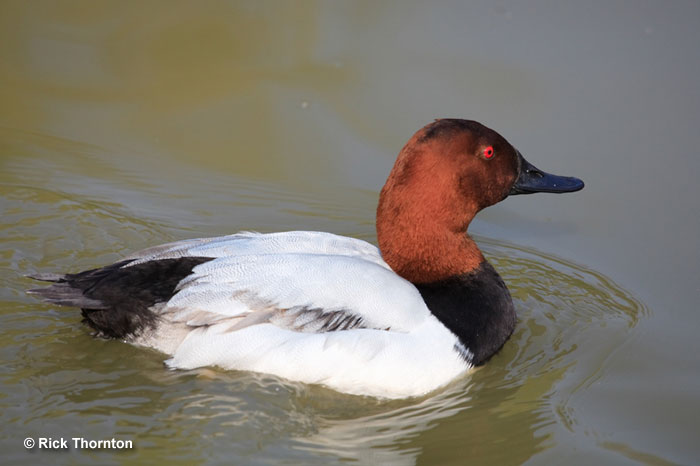
Scientific name: Aythya valisineria
Length: 21 inches
Wingspan: 29 inches
Canvasbacks are distinctive, medium-sized ducks with a long, gently sloping, black beak. No other duck in North America has a beak like the Canvasback, and maybe nowhere else either!
Males have a beautiful, dark chestnut head, dark eyes, black chest, and a pale gray and white body. They also have a black rump, tail, and undertail.
Female Canvasbacks have the same shape as male birds but look quite different. They are pale gray with a sandy brown chest, neck, and head. In flight, both sexes show a lot of white on their underwings.
This duck species dives underwater to forage for mollusks and other aquatic creatures.
Canvasbacks breed in shallow marshes in Alaska, western Canada, and parts of the western USA. Flocks migrate through most parts of the USA. In winter, large flocks of Canvasbacks can be spotted in Florida, along with other coastal areas.
Key identifications:
- Big, long, blackish, sloped beak.
- Male has black chest, pale gray body, and dark chestnut head.
- Female has brownish-gray body, and pale brown head and chest.
Gadwall
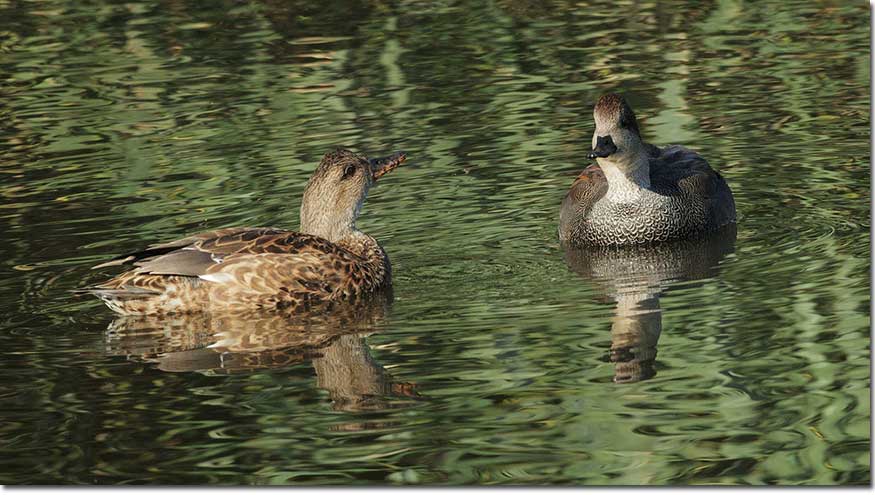
Scientific name: Mareca strepera
Length: 20 inches
Wingspan: 33 inches
Gadwalls are medium-sized ducks with a small white patch on the base of each wing. Males are gray ducks with a paler grayish head, some brown feathers on their wings, and a black rump, tail, and undertail.
Female Gadwalls look a lot like female Mallards and have gray-brown plumage with buff markings, and a paler grayish head. Like hen Mallards, they also have an orange and black beak but it is mostly gray on the upper part of the bill.
In flight, both sexes show white bellies, the small white mark on their wing, and much white on their underwings.
Gadwalls forage for seeds and other plant matter in and near shallow water.
These ducks breed in shallow wetlands in central and western Canada, and in various parts of the northern and western USA. They migrate through much of the USA and winter in coastal areas from Alaska to California, and in many western and southern states.
Key identifications:
- Male is mostly gray with black rear end.
- Female has grayish head and gray and orange beak.
- Small white patch on base of wing.
Greater Scaup
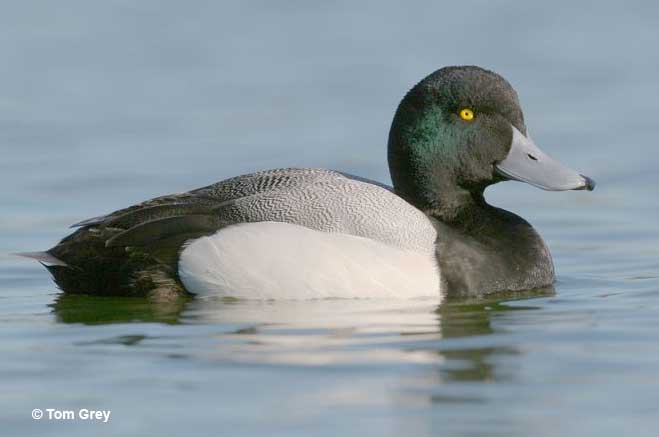
Scientific name: Aythya marila
Length: 18 inches
Wingspan: 28 inches
Greater Scaups are medium-sized ducks with pretty hefty, bluish beaks, and a rounded head with a pronounced forehead. Males have white bodies with pale gray backs, a blackish head with green iridescence, black chest, and black rump, tail, and undertail.
Female Greater Scaups are gray-brown birds that are darker brown on their heads, chest, and rear end. They also have a white patch on the front of their face. Both sexes also have pale eyes, and, in flight, show white bellies, and a broad white stripe on most of their wings.
Greater Scaups dive underwater to forage for mollusks and some other creatures.
This duck species breeds on lakes and shallow wetlands pretty far north! They mostly nest in remote areas of Alaska, and northern Canada. Flocks migrate through much of Canada and the central and eastern USA to winter in bays on both coasts and some large inland lakes.
Key identifications:
- Large, blue-gray beak with black tip.
- Rounded head that has a prominent projecting forehead.
- In flight, white stripe that nearly reaches the tip of the wing.
Common Goldeneye
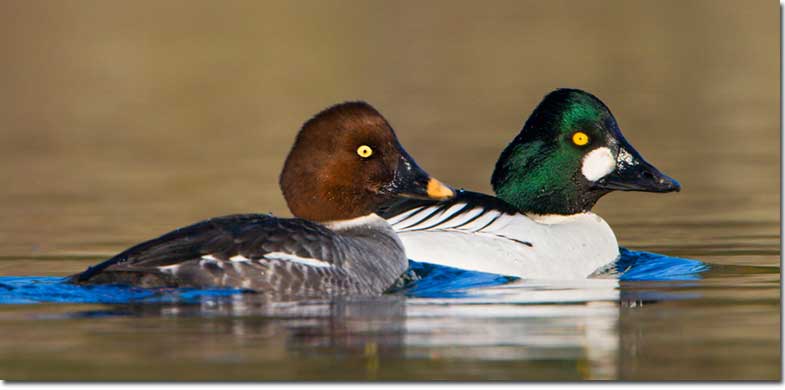
Scientific name: Bucephala clangula
Length: 18.5 inches
Wingspan: 26 inches
Common Goldeneyes are small ducks with a stout, triangular beak. Males are mostly white with some black markings and have green iridescence on their black heads. They also have a round white patch on their face.
Female Common Goldeneyes have gray bodies with a white belly, a pale collar, and a dark, gray-brown head. They also usually have a pale tip on their beaks.
Both sexes of this pretty little duck have pale eyes, and, in flight, show big white patches on the base of their wings.
When the breeding season is over, they form flocks that migrate to coastal areas, lakes, and other bodies of water in most of the USA – including Florida.
These cute ducks dive underwater to forage for small mollusks and other aquatic creatures.
Key identifications:
- Small duck with a fairly large, stout blackish beak, and pale eyes.
- Male is black and white with a round white mark on his green-black face.
- Female has mostly gray body with a dark brown head.
Long-tailed Duck
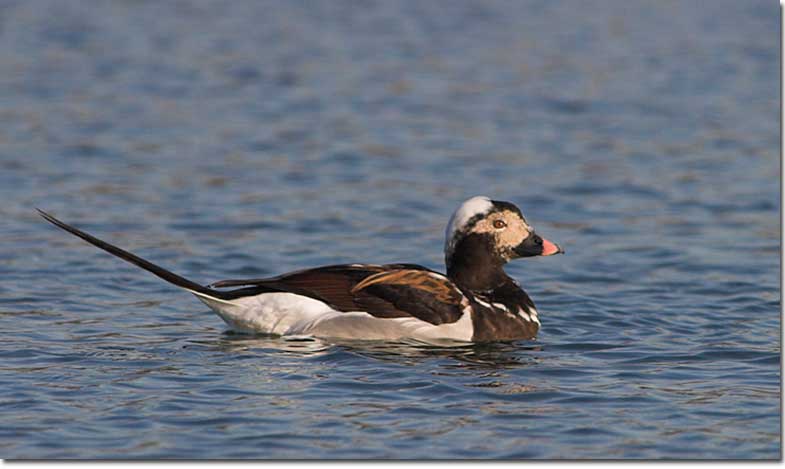
Scientific name: Clangula hyemalis
Length: 16.5 inches
Wingspan: 28 inches
Long-tailed Ducks are small pale ducks at home on cold, Arctic tundra lakes. Breeding males have smart-looking, black plumage with a pale gray face patch, white belly and sides, and some brown feathers on their back.
They also have long, black central tail feathers! However, since they live so far north, not a whole lot of people get to see them in their breeding plumage. Most male Long-tailed Ducks that birders see have much more white on their heads, necks, and chests and silvery feathers on their backs.
Females don’t look as exotic and lack the male’s long tail feathers, but they are still nice to see! They are gray-brown with white on their head, belly, and undertail.
Both sexes have fairly broad black wings and forage for small aquatic animals by diving underwater. These small ducks breed on ponds and other wetlands but flocks winter in coastal waters on both coasts and some large lakes.
Key identifications:
- White belly, dark chest, and broad, black wings.
- Small beak, and gray and white plumage with some black markings.
- Pointed tail (very long in male).
Cinnamon Teal
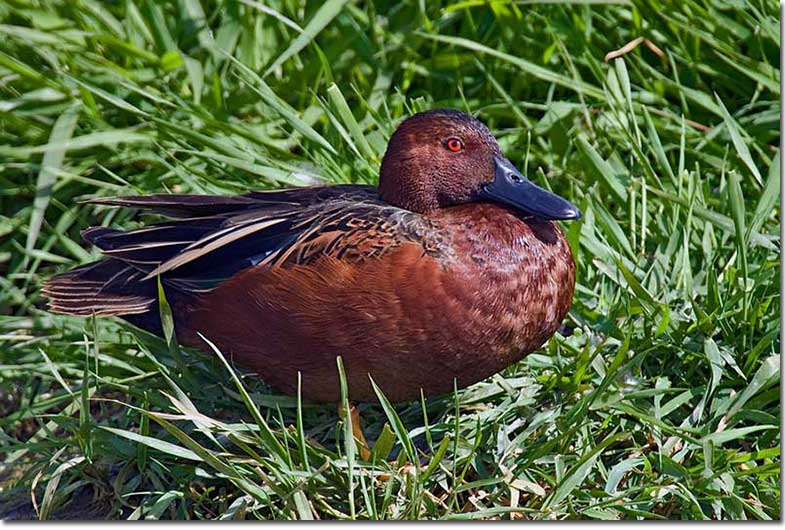
Scientific name: Spatula cyanoptera
Length: 16 inches
Wingspan: 22 inches
Cinnamon Teals are small ducks with reddish eyes and a fairly large, dark beak. Breeding males are one of the most handsome ducks in North America. When competing with species like the Hooded Merganser, Redhead, and Northern Shoveler, that’s saying something. However, I stand by my word!
Male Cinnamon Teals are a beautiful, reddish-chestnut highlighted by caramel-colored plumes on their back. They also have a black rump and undertail, and show pale blue shoulders in flight.
Females and non-breeding males are duller, brown birds with mottled buff markings. They also have a plain pale brown face that lacks a dark line through their eye but still show a pale blue shoulder in flight.
Cinnamon Teals dabble for plant matter and small creatures in shallow marshes and at the edges of shallow lakes. They breed in parts of western Canada and much of the western USA, and mostly winter in California, southern Arizona, and southern Texas. They can rarely be spotted in Florida.
Key identifications:
- Rich, red-brown plumage.
- Female has a reddish eye and a plain face.
- Blue or blue-gray shoulders on its wings.
Frequently Asked Questions
How many ducks can be found in Florida?
More than 30 ducks can be found in Florida. According to eBird, 35 native duck species have been seen in the state. Several are rare vagrants, but most are fairly common.
What is the most common duck in Florida?
The most common duck in Florida is the Black-bellied Whistling-Duck. According to eBird, this duck species is seen more often than any other duck species in the state.
Are there Mallard ducks in Florida?
Yes, there are Mallard ducks in Florida. They aren’t as common as other places further north but they do occur.
Why are there so many Muscovy Ducks in Florida?
There are so many Muscovy Ducks in Florida because the state has a lot of good wetland habitat for them.
Are ducks invasive in Florida?
Some ducks are invasive in Florida but most species are native.
Read next: Birds of Florida | Hawks in FL | Owls in FL | Woodpeckers in FL | Hummingbirds in FL

